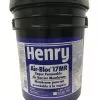Henry 789 Asphalt 5G
$64.80
- Can be used above-grade to provide a “breathable” moisture barrier, used for damp proofing the exterior walls in cavity wall construction
- Excellent for lining concrete and masonry planters
- May be used on “green”, uncured, or damp surfaces
- Cold applied, corrosion resistant
- Fibers aid sag resistance in vertical applications
- Resilient—does not crack, alligator, run or sag
- Meets ASTM D1227, Type II Class 1, and ASTM D1187 Type I
211 in stock
Henry 789 Asphalt 5G
Henry 789 Fiber Asphalt Emulsion Damproofing is designed for damproofing the exterior side of below grade foundations and walls. Above grade, Henry 789 provides a moisture barrier used for damppoofing the exterior walls in cavity wall construction. Made from selected asphalt, emulsified with bentonite clay, non-asbestos fibers, and water. It contains no solvents. Questions? Contact Us.
Stir coating thoroughly. A tighter bond will result if surface is damp when coating is applied. Apply with a soft bristle brush or heavy duty spray equipment. For best results keep brush strokes in one direction and apply additional coats at a right angle to the former coat. Avoid excessive brushing. For spraying, use Graco 9:1 ratio pump, or equal, capable of delivering 3 – 5 gallons per minute, and a pole gun with 1/8″ – 1/4″ tip. A 3/4″ I.D. material hose from the pump gun is preferred for most applications.
Dampproofing of Exterior Surfaces Below Grade – Dense Surfaces: For dense concrete surfaces not subject to hydrostatic pressure, a single coat of Henry 789 – FIB ASPHALT EMULSION DAMPPROOFING, approximately 1/16″ in
thickness is generally adequate. If applying by spray or for severe conditions, two coats are preferable. Apply each coat at 2 to 3 gallons per 100 square feet, allowing the first coat to dry before applying second coat. Fill in all crevices and grooves, making sure coating is continuous and free from breaks and pinholes. Carry coating over exposed top and outside edge of footing. Spread around all joints, grooves, and slots and into all chases, reveals, and soffits. Bring the coating to finish grade.
Dampproofing of Exterior Surfaces Below Grade – Porous Surfaces: For dampproofing of porous surfaces such as concrete block, 3 alternate techniques are equally effective (base your selection upon local preference and the availability of equipment).
A) Two Coat System: Apply a base coat of HE789 – FIB ASPHALT EMULSION DAMPPROOFING, cut 20% by volume with clean water, over entire prepared surface. Apply base coat at a rate of 1.5 gal. per 100 sq. ft. Allow base coat to dry to tacky touch and apply 1 coat of HE789 – FIB ASPHALT EMULSION DAMPPROOFING as described under Dense Surfaces. Allow to set 24 to 48 hours before backfilling as described previously.
B) Membrane system: For severe conditions or added protection, apply a base coat followed by a coat of HE789 – FIB
ASPHALT EMULSION DAMPPROOFING as described above. Within 2 hours, apply Henry # 183 Glass Fabric membrane over all surfaces of coating, overlapping edges at least 3 to 4″. Embed glass fabric into coating without
wrinkles or buckles. Within 24 hours, apply an additional coat of HE789 – FIB ASPHALT EMULSION DAMPPROOFING and allow to set for at least 24 to 48 hours and backfill as previously described.
C) Parge Coat System: Apply a parge coat of cement mortar to the block wall, carrying the parge coat from the bottom of the footings to grade level and forming a cove at the junction of the wall and footing. Allow to cure. Apply 1 to 2 coats of HE789 – FIB ASPHALT EMULSION DAMPPROOFING as described under Dense Surfaces. Allow to set and then backfill as previously described.
Interior Surfaces Above Grade – Weather Resistive Barrier: HE789 – FIB ASPHALT EMULSION DAMPPROOFING is used for dampproofing the exterior face of interior walls in cavity wall construction. HE789 – FIB ASPHALT
EMULSION DAMPPROOFING is compatible with masonry, concrete, CMU, and gypsum sheathing. Apply product in 1 coat, carrying the coat in and around all joints, grooves and slots, following all reveals and soffits of windows and
continuing 12″ out on adjoining partitions and soffits. Allow to set. If walls are to receive hard wall plaster, use furring strips or metal lath.
Drying: Usually 8 to 12 hours in warm, dry weather. Drying will be slower, 2 to 7 days, in cool, damp weather. Allow to dry between coats. On below-grade foundations, let cure at least 24 to 48 hours, with good air circulation, before
exposure to water or backfilling. Use forced air if needed. COATING BECOMES WATERPROOF ONLY AFTER DRYING THOROUGHLY. Test for dryness in slowest drying area by vigorously rubbing the surface with a wet finger.
Coating is dry if no staining occurs. The dry membrane should be protected from back-filling damage by installing Henry Protection Board, adhered with Henry #204® Plastic Roof Cement.
| Weight | 50 lbs |
|---|---|
| Dimensions | 15 × 15 × 18 in |
Related products
All Products
All Products
All Products
All Products















